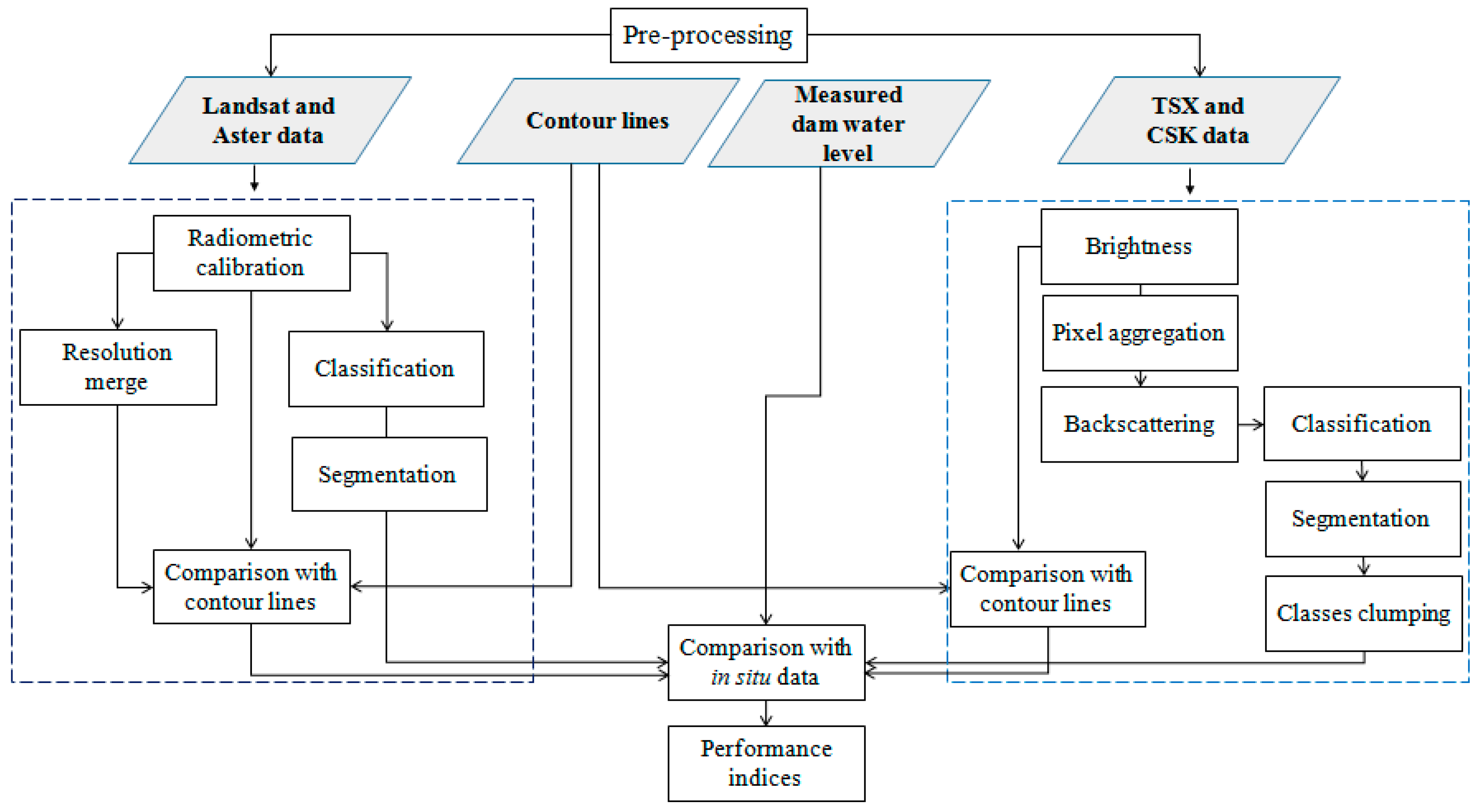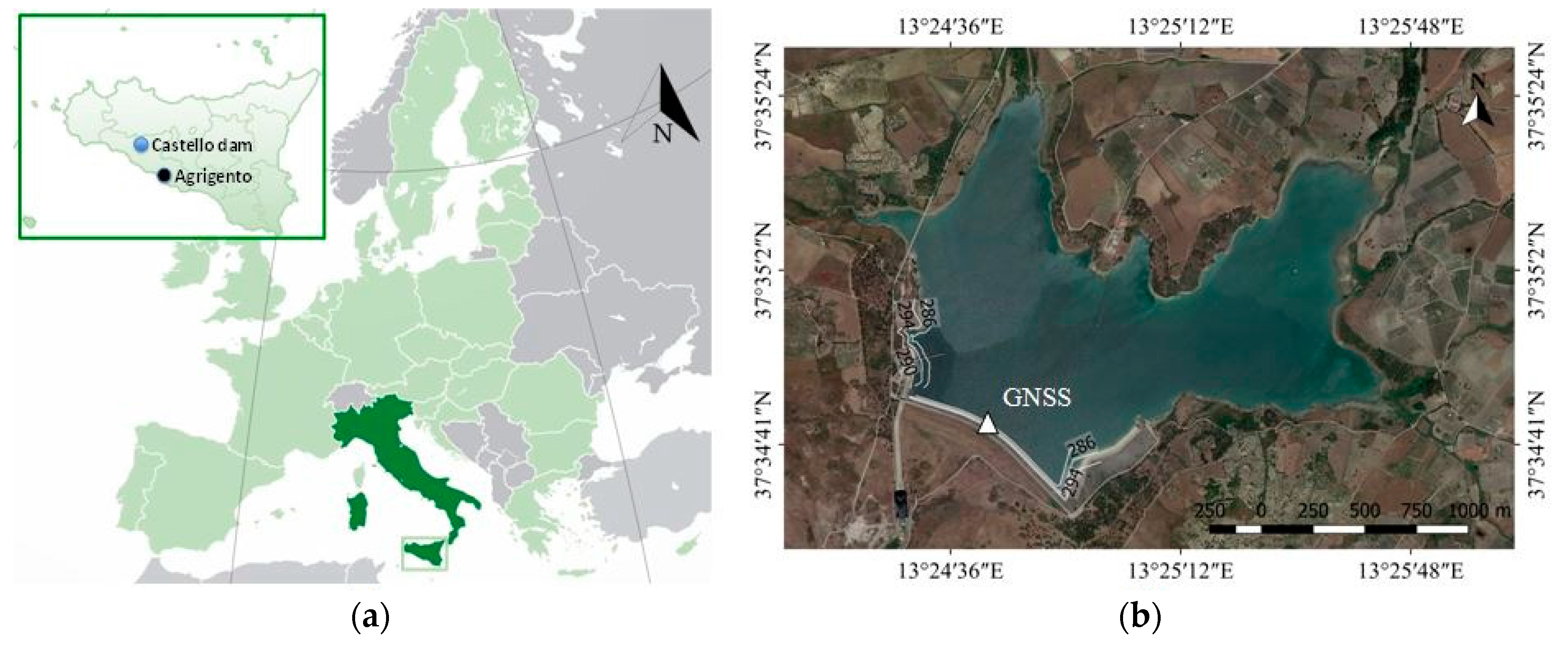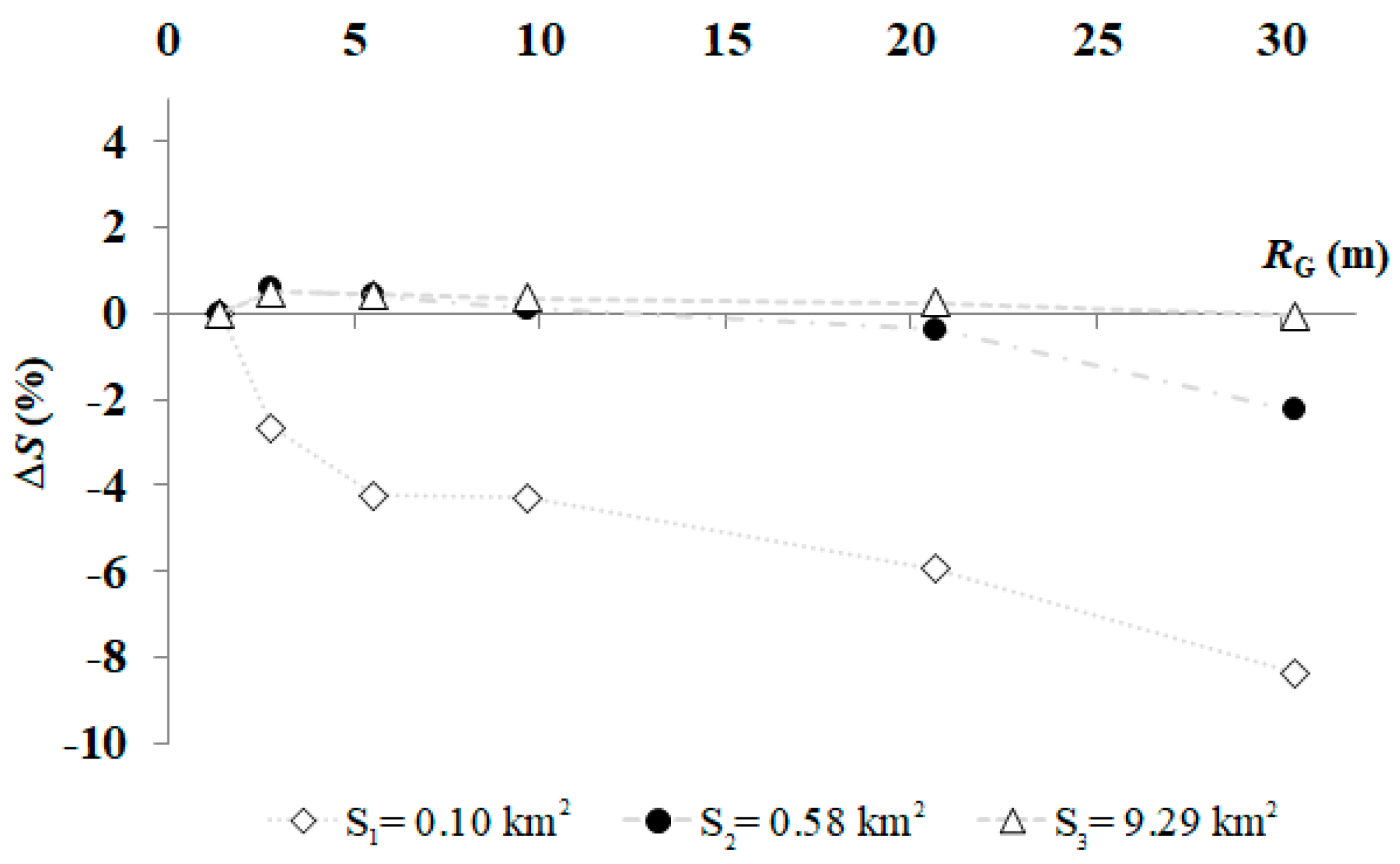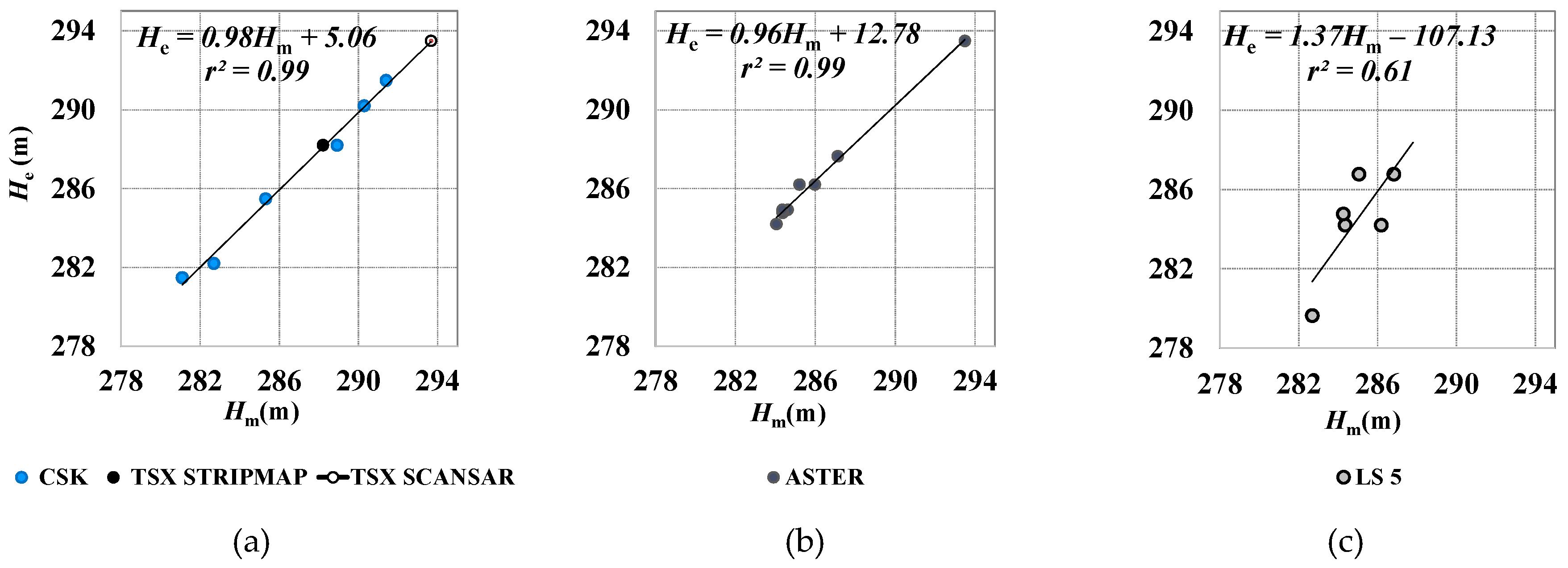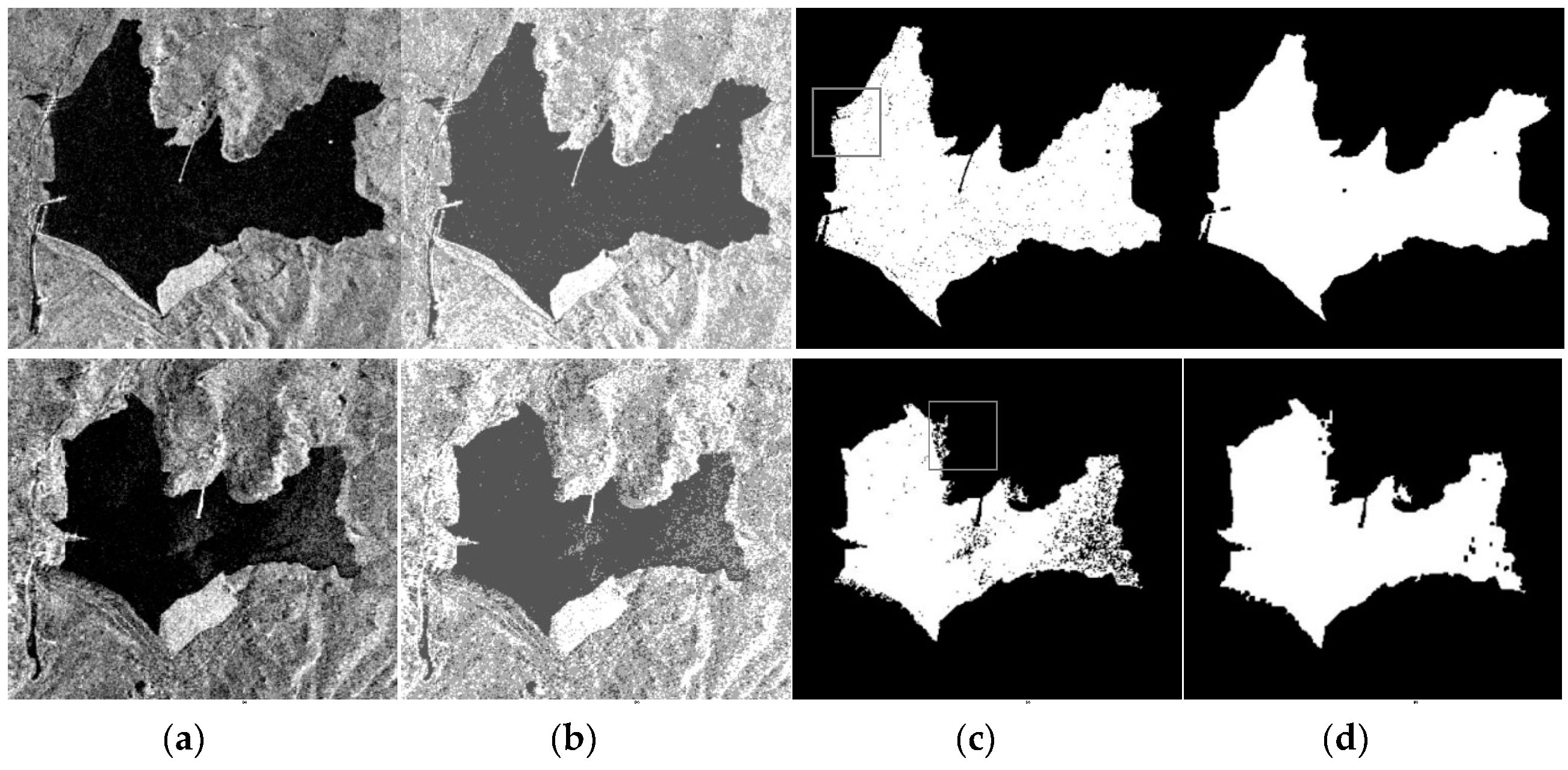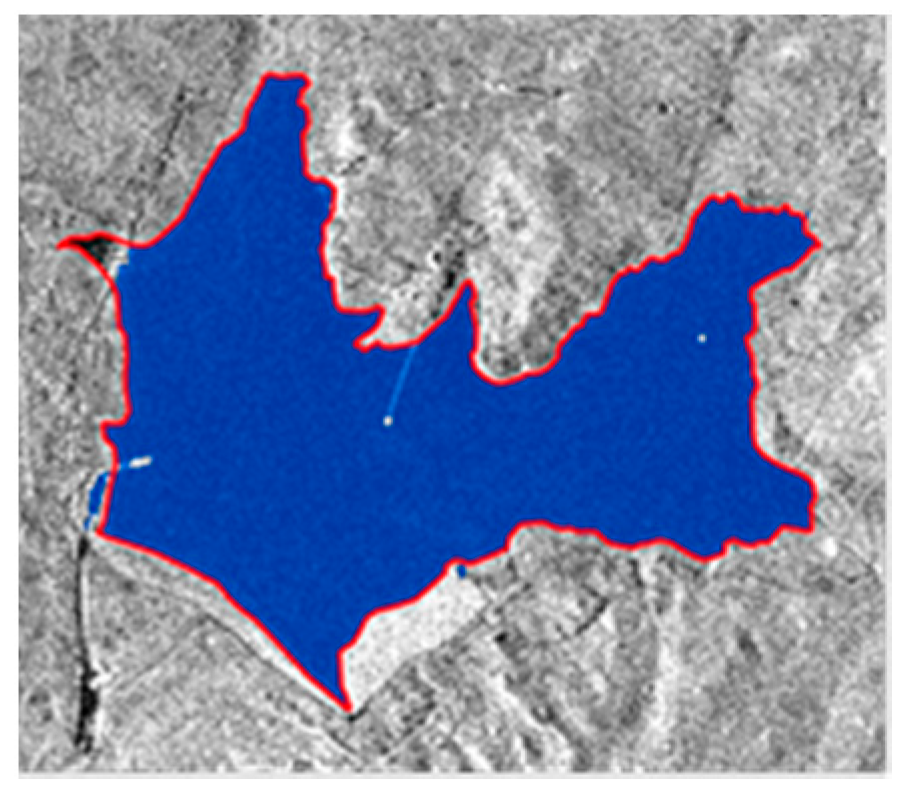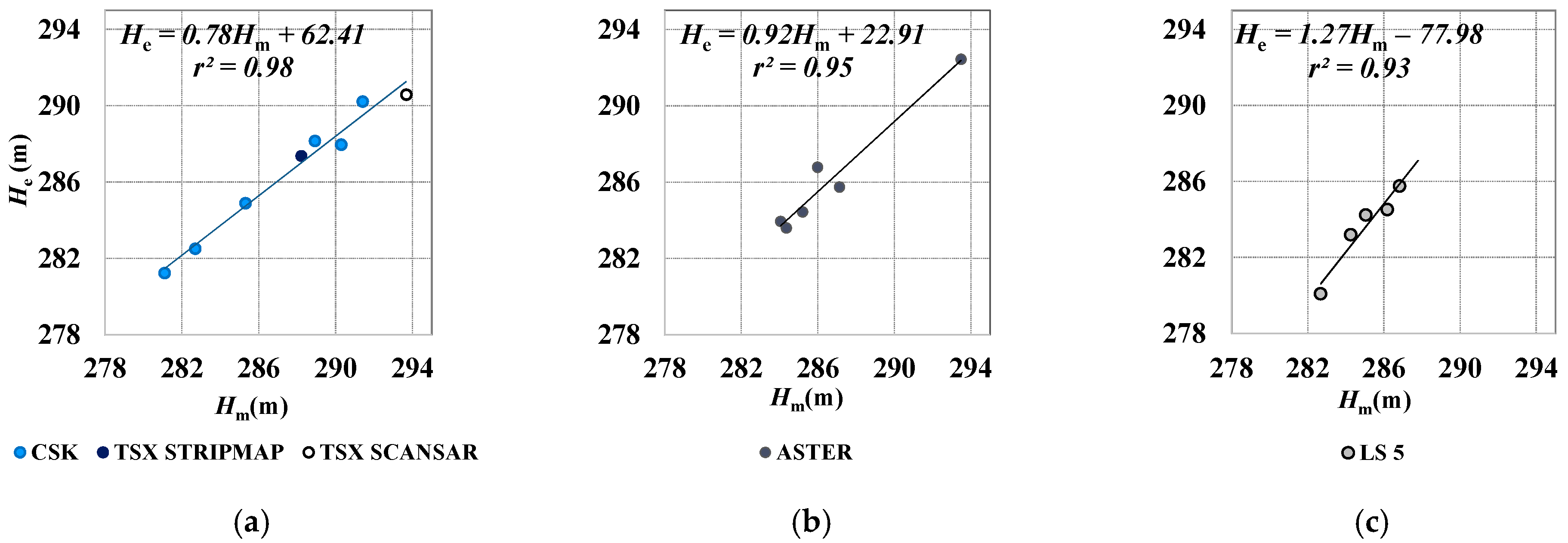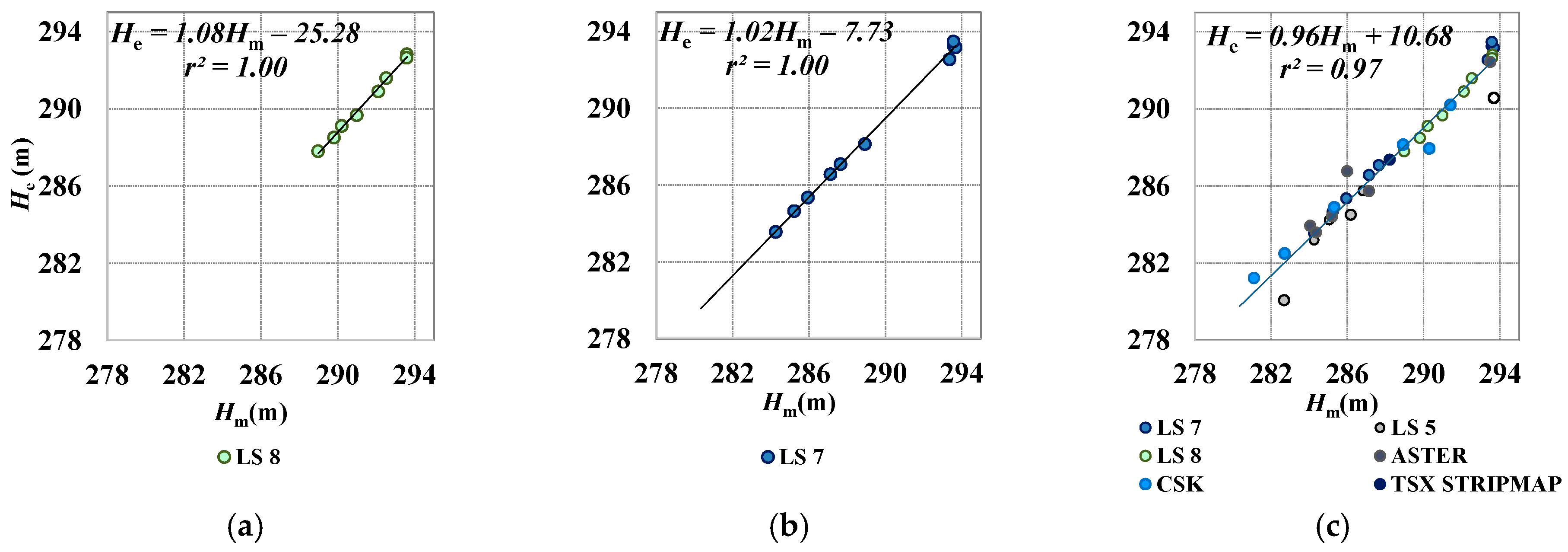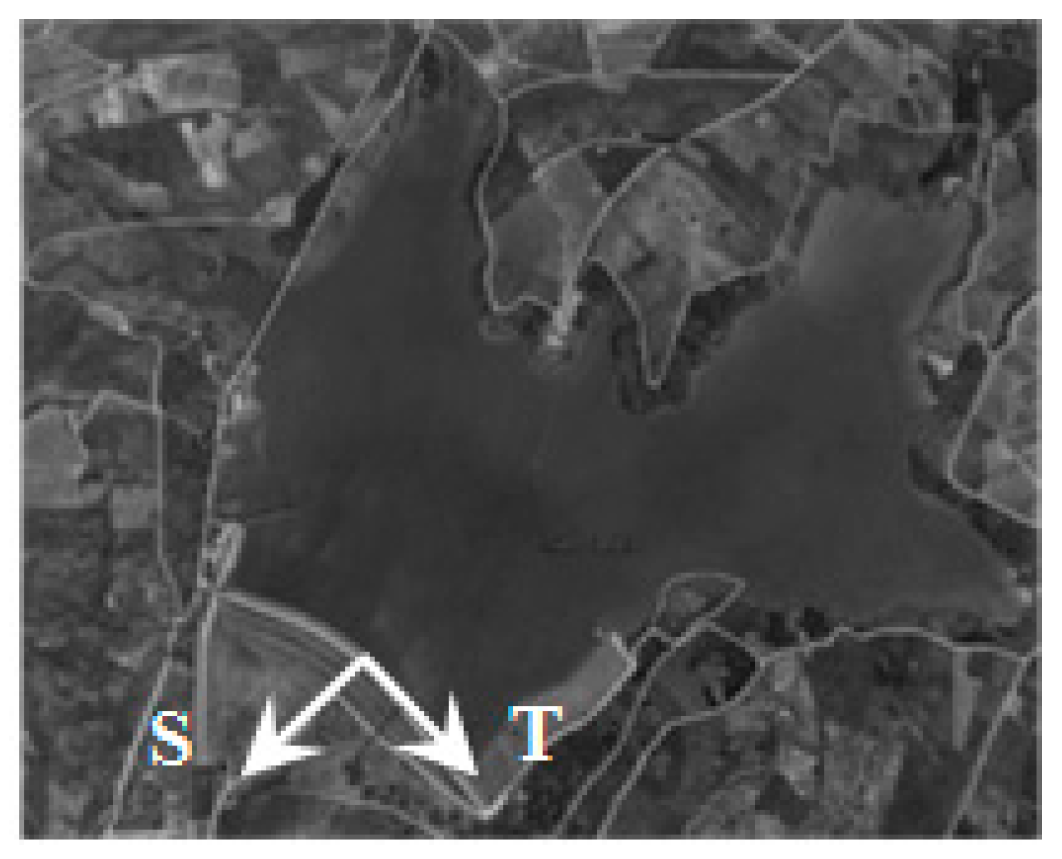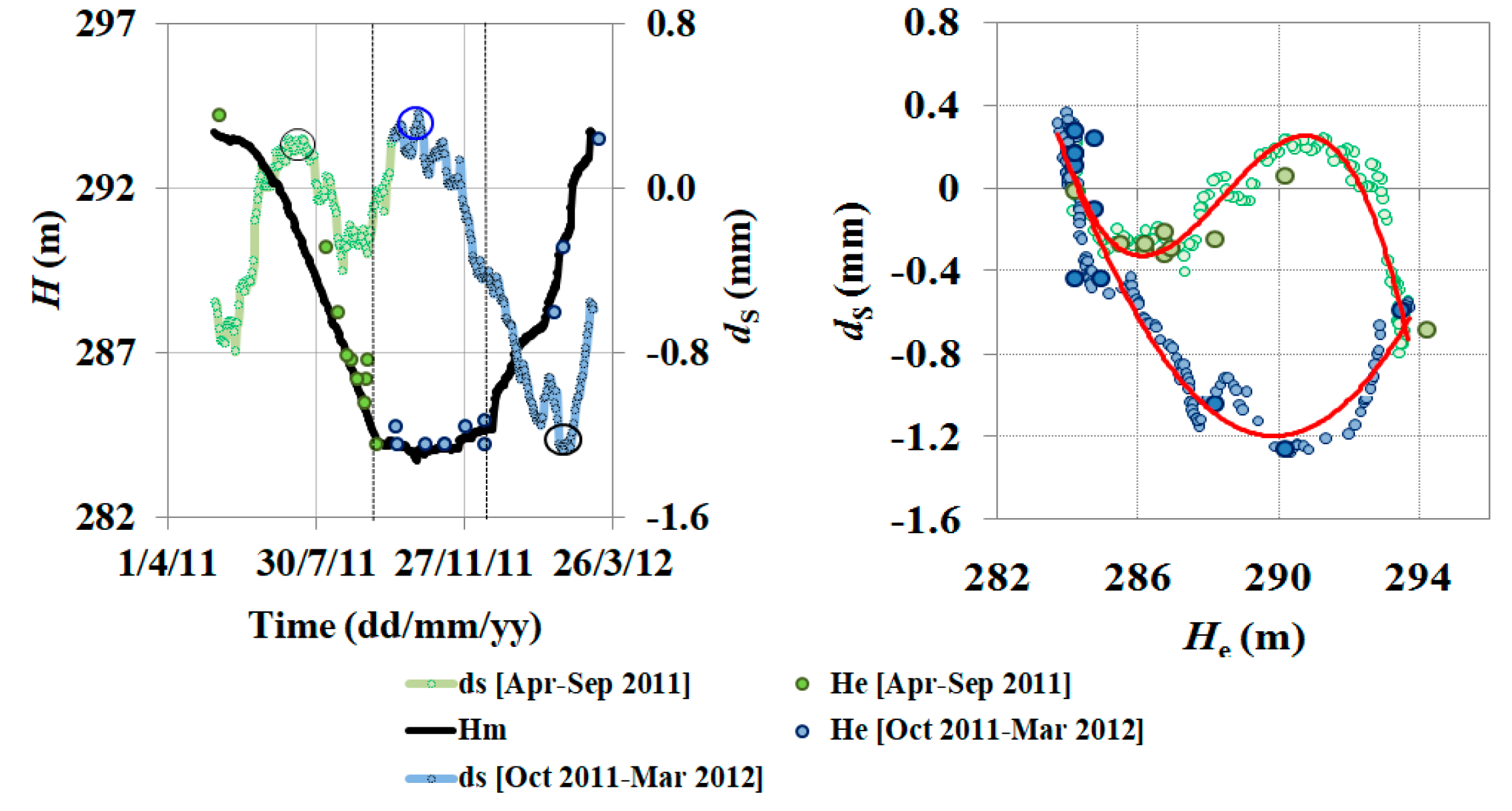Water levels recorded in situ were compared with levels determined via visual matching and unsupervised classification techniques. The visual matching allowed straightforward identification of the water level by matching the bounds with the closest contour line. Thus, it is based on the operator choice and therefore it is subjective. However, image classification could be automated, and thus, once classification parameters have been set up, it is objective. However, its limit resides on the algorithm performance when clouds, shadows, or missed lines degrade the quality of the image.
5.1.3. Classification
The unsupervised classification allowed estimation of the surface extension of the water body, while the subsequent segmentation enabled the exclusion of all pixels not connected with the water body but classified in the same class. The smallest segment was set equal to the number of pixels corresponding to a minimum reservoir surface during the entire time series (0.72 km
2, 12 September 2012); this minimum pixel number was varying with
RG. Connectivity was set equal to 4 neighbor pixels (
Table 5).
The reduction, in terms of pixels classified as water surface is maximum for high-resolution grayscale images (~36 ± 17%, SAR Stripmap), and is small or even negligible for average resolution multispectral images (<3 ± 2%). Thus, image segmentation was particularly necessary over SAR images acquired at high geometric resolution. A class clumping algorithm was applied after segmentation by setting a 3 × 3 kernel. The clump allowed for the filling of pixels not classified as lake but positioned within the water body boundary. Water body boundary, conversely, was slight smoothed.
Segmentation statistic for ASTER images refer to three scenes acquired on the 3 August 2012 and 26 August 2012, and on the 9 May 2013. The other three images are characterized by partially cloudy conditions; for those images the average pixels’ reduction and standard deviation were ≈33.1 ± 1.9%. When clouds or shadows are positioned within the area of interest but do not cover the lake extension (e.g., ASTER scene acquired on the 1 January 2013, not shown here) segmentation produces a distinct segment that can therefore be removed. When clouds or shadows cover the lake extension (e.g., ASTER scene acquired on the 9 September 2011, not shown here), segmentation generates a unique segment causing an overestimation of the lake’s surface.
The clumping process was particularly effective over two CSK images acquired when the water surface was rough due to wind intensity and direction; over these images, a sharp increase in the number of pixels finally associated with the water body (~10%) was found.
The classification of a CSK image acquired during a still day (
Figure 8, upper panels) shows a clear delimitation of the main water body. Segmentation removed a small-disjoined segment since a branch of the reservoir was apparently disconnected from the main water body due to a bridge crossing it (west north-west zone of the reservoir,
Figure 8c). A CSK image characterized by local windy conditions (10 September 2012) has shown limits in the classification performance (lower panels, a–d). Segmentation removes most of the pixels outside the water body even though some misclassified pixels remain (northern branch of the reservoir, lower panel,
Figure 8c). The clumping process is not able to remove all pixels within the reservoir not classified as water (
Figure 8d).
Although wind intensity and direction reduces the performance of the classification procedure, new radar satellites, such as the four radar satellites of the COSMO-SkyMed constellation offer a low revisit time (≤12 h for CSK) [
36] comparable to in situ measurements (daily). Thus, discarding some images should not affect the operational applicability of the technique.
The comparison between the area resulting from the classification procedure (1.259 km
2,
Figure 9, blue polygon) and the area evaluated via hand-digitization (1.265 km
2, red boundary) confirms the accuracy of the procedure (0.48% of underestimation for the selected still day CSK image).
Water levels resulting from SAR, ASTER and LS5 processing are compared to water levels measured in situ (
Figure 10a–c, respectively).
Both residual speckle and local wind speed and direction could influence SAR backscattering [
37], thus SAR images require a specific setting of both segmentation and class clumping algorithms as specified in the methods section. Because water,
σ0 is similar to that characterizing surrounding land, images influenced by wind generally provide estimated levels lower than the measured ones.
Two partially cloudy ASTER images were not used after the classification, since this algorithm was not able to identify the water surface. Also, two LS5 images were not suitable for classification since the gap size did not allow an accurate water surface estimation. However, the estimated correlation was very high for all the different images (r2 ~ 0.9). For LS5 data, the classification was applied just after a layer stacking representing the SWIR and NIR bands, because using all the MS available bands in many cases caused the classification process to fail, while using just the three bands meant the reservoir surface was easily determined.
Difficulties arise when RM was applied to LS8 and LS7 images. Despite an increase in the spatial resolution, the technique carries in the SWIR bands disturbances occurring in the visible bands. The panchromatic covers green, G, to NIR (specifically, 0.52 to 0.90 μm in LS7 and 0.50 to 0.68 μm in LS8). If applied on the whole MS images, RM damages SWIR bands when glint occurs in the visible bands. In these cases, water pixels are misclassified.
For that just the MS bands in the SWIR and NIR were used, with a resolution of 30 m, and then the segmentation process was applied. Before the classification, for LS7 SLC-Off data, the ENVI-IDL RBV method was used to fill the missing pixels inside the reservoir.
The reservoir is positioned on the central part of the Landsat scene 189/34 (~57 km from the left boundary) and on the lower right part of the Landsat scene 190/34 (~8 km from the right boundary). The position and the percentage of un-scanned rows and cloudiness inside the basin also differed. The average width of un-scanned rows is approximately 200 m for the scene 189/34, 400 m for the 190/34. In a previous work, the surface underestimation of a reservoir using the K-means clustering algorithm was analyzed, by applying synthetic stripes simulating the un-scanned rows in the LS7 SLC-Off data [
16]. It was found that with the increasing ratio between total width of un-scanned rows (
LS) and length of the water body orthogonal to the scan line direction (
LL), came decreasing algorithm performance. Evaluated values of the characteristic ratios
LS/
LL were 0.033, 0.067, 0.133, and 0.200. A maximum underestimation of ~10% was considered suitable and using the MS bands, the obtained acceptable estimate for the ratio was lower than ~0.17.
Gaps characterizing the Castello dam on Magazzolo reservoir within the scene 189/34 have a characteristic ratio LS/LL < 0.17, thus the algorithm performance was considered satisfactory. On the contrary, LS/ LL over the scene 190/34 was higher than 0.2, thus these images were excluded from the analysis.
Moreover, some cases could occur where un-scanned rows are positioned along the dam or along a reservoir boundary that is almost parallel to the scan line. In both cases, because the loss of shape information, the RBV algorithm fails to rebuild the reservoir shape. Thus, all LS7 190/34 scenes (14 images) were excluded from the analysis, as well as two 189/34 scenes characterized by high clouds coverage or by missing scan lines coincident with the lake shoreline. Water levels estimated from LS8 and LS7 were compared to measured values (
Figure 11).
Very high correlation (r2 = 1.00) and low S.E. (0.14 and 0.21 m) were found between Hm and He derived from LS8 and LS7, respectively, although, few Landsat images were used (8 LS8 and 10 LS7). High correlation (r2 > 0.9) was also found applying the classification method on the whole dataset, although S.E. was relatively high (0.70 m).
Although the unsupervised classification promises high performances, it presents many limitations. The method is influenced by cloudiness and shadows. When LS7 SLC-Off images need to be processed, the preliminary gap filling is a point of weakness for the accuracy of the subsequent classification. It needs to be highlighted that the position and the average width of the gap within the scene, for a given location, change with the acquisition path. In particular, it depends on the distance with the limits of the scene.
After the first screening of the dataset (cloud cover, scan-lines missing, shadows), 37 images were used for the analysis. Main statistical indicators used to evaluate the performance of the different methods are summarized in
Table 6. Statistics includes the slope (
m), the intercept (
q),
r,
S.E. and
p value, for visual matching (M) and unsupervised classification (C) techniques, with the available number of images reported between parentheses. Best values are formatted in black bold, worst values in blue bold.
Main statistical indicators have shown that: (i) the classification procedure performed better on optical data when SWIR and NIR bands were used for visualization (LS7, m = 1.02, r = 1.00 and LS8, S.E. = 0.14 m, r = 1.00) while performed worst on optical images characterized by few spectral bands (this LS5 dataset, m = 1.27). Residual speckle and local wind effects on SAR single polarization (XHH) band caused an underestimation of the water class (m = 0.78) although the correlation remained strong (r = 0.99); (ii) the visual matching produced best results on LS8 with a slight overestimate of the water levels (m = 1.04) although the correlation remained high (r = 0.95). Worst results occur when the technique is applied on LS5 images, with a strong overestimation (m = 1.37), low correlation (r = 0.78) and high standard error of the estimates (S.E. = 1.83 m). Also, for most of the analyzed dataset the correlation is significant and very strong (r > 0.9 and p < 0.01), just for LS5 with classification technique the p value highlights a lower significance (r = 0.78 and p = 6.7 × 10−2). Overall, the classification technique allows reaching a lower S.E. (0.70 m) and a significance level of 4.3 × 10−27, although a limited number of images is suitable to be processed (<70% of the whole dataset in this case), while, the visual matching technique despite a higher S.E. (0.92 m) can be applied to almost the whole dataset (~90%) allowing a better estimate of the water level compared to the classification technique.
